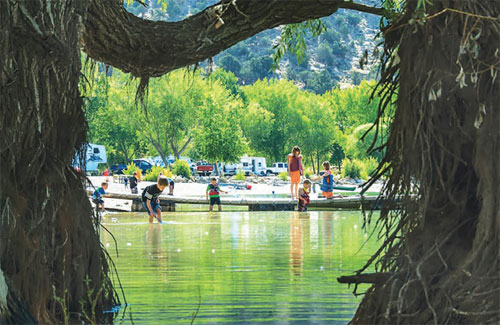By Brice Wallace
“Sobering.” “Dire.”
Those are a couple of descriptions of the COVID-19 impacts on Utah’s tourism industry.
Vicki Varela, managing director of tourism and film at the Governor’s Office of Economic Development, recently told a videoconference audience that visitor spending in the state is only one-tenth what it would be during normal times.
And that was before Capital Reef and Arches national parks were closed and before Gov. Gary Herbert restricted state parks to people living in the county where the parks are located.
Varela said the industry’s $9.75 billion annual visitor spending equates to $26 million each day. “We’re at 10 percent of that, at the very best, right now,” she said during the conference, meaning daily losses of at least $20 million.
And the outlook in the Salt Lake County area also is grim. A business impact survey by Entrata Insights for Visit Salt Lake shows that 69 percent of the surveyed Salt Lake tourism businesses are facing declining gross business revenues of 75 percent or more in the next 30 days, 67 percent are considering layoffs in next 30 days, and 50 percent expect to run out of cash in next 60 days. Only 12 percent of Salt Lake tourism businesses can sustain their business operations for five months or more, the results show.
“It’s a sobering report,” said Derek Miller, president and CEO of the Salt Lake Chamber and chairman of the Utah Economic Response Task Force.
“I’m in conversations every day with longtime guides and outfitters, hoteliers and restauranteurs who are facing the question of whether they will make it another day,” Varela said.
For example, one tour bus operator has only five of his 107 buses in use, she said. The Utah Office of Tourism website describes the situation as “difficult and surreal days for our industry and for the world.”
The tourism office has responded to the virus, in part, by stopping its mass marketing efforts.
“We’re not out there promoting travel right now,” she said. “It wouldn’t be responsible. … But we are starting to innovate around how we will get back into market when it’s the right time.
“We can’t just go back to ‘business as usual’ because we’ve had such a significant drop in everything that we’ve got to have ‘Mighty 5’ type of innovation when we come back into the market, so we’re working on that marketing strategy.”
Among innovative approaches to the virus in the tourism industry are hotels talking to counties and hospitals to accommodate the overflow of patients, restaurants becoming resource centers for affected workers, and distilleries started to produce sanitizers.
“We’re doing all that we can in every sector to try to get through this and to try to help protect public safety,” Varela said.
The Entrata Insights survey March 18-25 included 140 respondent tourism businesses that have 7,800 full-time-equivalent employees and over $1 billion in combined revenue. The survey report points out that tourism jobs are labor-intensive and cannot be replaced by telework.
The hope is that poring over the results will help guide the industry’s eventual rebound.
“The results are kind of dire and it’s hard to hear, but what it does do is it baselines for us to know what we need to do to bring that recovery forward and make sure we can benchmark that along the way so that we can know when we have really started [along] that road,” said Kaitlin Eskelson, president and CEO of Visit Salt Lake.
“The news they gave back was sobering,” said Esra Calvert, chief data advisor at Entrata, “but it also gives us concrete information to figure out how to start solving the problem. … The more we know about exactly where the pain is, where the problems are, the better we can start to address them. … This is the reality and the shock that we are living in from business revenue and workforce perspectives.”
Varela said she hopes that federal, state and local government programs can be used to help Utah’s tourism companies. “All of these tools,” she said, “are necessary for so many of our businesses to actually survive over the next 60-plus days.”








